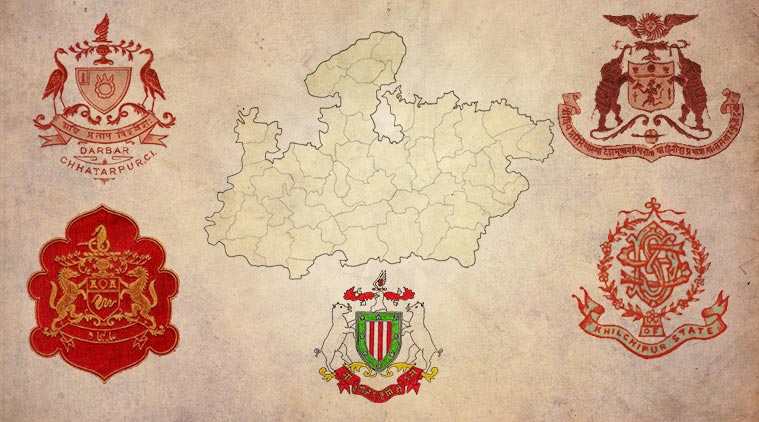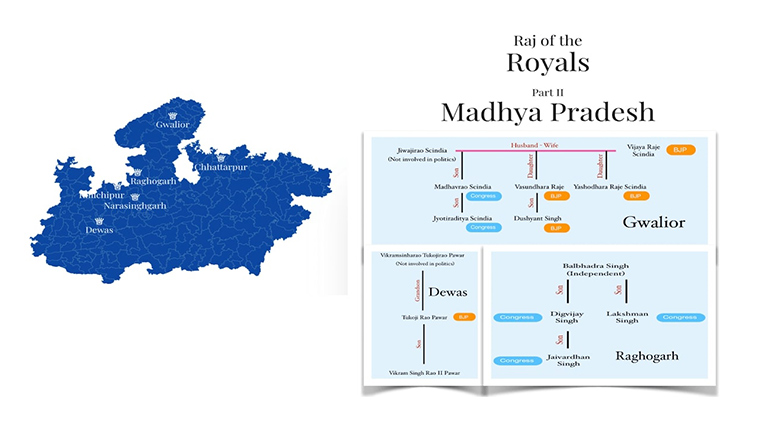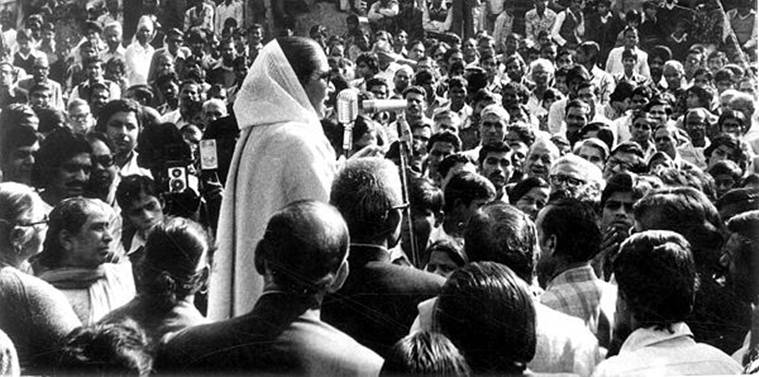
As Rajasthan, Madhya Pradesh and Chhattisgarh go to polls in the coming days, here is a look at how the erstwhile royalties of these states have continued to rule through modern political mechanisms.

Madhya Pradesh
After the Independence of the country, the princely states that were part of the Central India Agency came together to form a union called Madhya Bharat. Jiwajirao Scindia who was the head of the Gwalior state at that point in time was appointed the first Rajpramukh (governor) of Madhya Bharat. Later in 1956, Madhya Bharat was merged with the states of Vindhya Pradesh and Bhopal state to form Madhya Pradesh. Consisting of a large number of erstwhile princely states, the royal families in this region have continued to exercise their authority since the days of Madhya Bharat. Perhaps the most powerful among them are the Scindias of Gwalior whose involvement and success in politics goes back to the days immediately following the birth of an independent India. Moreover, the Scindias are also spread out across parties and states. Similar influence can also be found among the Raghogarh royals. There are others like the Rewa and Raigarh royal families whose former heads were successful politicians, but currently, the scions have maintained distance from active politics.
Gwalior
The Scindias ruled the Gwalior state that was part of the Maratha Confederacy in the 18th and 19th centuries and later became a princely state during the colonial rule. During Independence, the state was under the leadership of Jiwajirao Scindia. He also became the first rajpramukh (governor) of erstwhile Madhya Bharat.
His wife, Vijaya Raje Scindia made her entry into politics in 1957 and remained a powerful name until her death in 2001. In her electoral debut, she contested and won the Guna Lok Sabha seat on a Congress ticket. Later she contested elections as part of Swantantra Party, the Bhartiya Jana Sangh, and the BJP. In 1980, she was made the vice-president of BJP and played a key role in the framing the Ram Janmabhoomi agenda.
Story continues below this ad
 Vijaya Raje Scindia made her entry into politics in 1957 and remained a powerful name until her death in 2001. (Express Archive photo)
Vijaya Raje Scindia made her entry into politics in 1957 and remained a powerful name until her death in 2001. (Express Archive photo)
Jiwajirao and Vijaya Raje Scindia had five children, three among them being active politicians. Their son Madhavrao Scindia was a nine-term member of the Lok Sabha. He first contested and won an election on a BJS ticket from Guna at the age of 26. But in 1980 he switched allegiance to the Congress. In 1984, he became the Railways Minister in the Rajiv Gandhi government. Later he also served as Minister of Aviation and Minister of Human Resource Development. He died in a plane crash in Uttar Pradesh in 2001. His son Jyotiraditya Scindia is currently a Congress MP from Guna constituency.
Vasundhara Raje, who is the daughter of Vijaya Raje Scindia, is the current chief minister of Rajasthan and part of the BJP. Raje was married to the scion of the Dholpur royal family in 1972, but they parted ways within a year. However, ever since she has been active in the state politics of Rajasthan. Previously she had served another term as chief minister of the state between 2003 and 2008. Raje’s son Dushyant Singh is a BJP politician and current member of the Lok Sabha representing Jhalawar-Baran constituency. He had been elected to the Lok Sabha twice in the past in 2004 and in 2009 from the same constituency.
Raje’s younger sister Yashodhara Raje Scindia is also a politician from the BJP. She is the current minister for Commerce, Industries and Employment in Madhya Pradesh and Chairman Madhya Pradesh State Industrial Development Corporation. She had won the 2013 Legislative Assembly elections from Shivpuri.
Raghogarh
The 12th ruler of Raghogarh, Balbhadra Singh ascended to the throne in 1945. He contested in the 1951 elections as an independent candidate and won a seat in the Raghogarh Vidhan Sabha constituency. Both his son, Digvijay Singh and Lakshman Singh are current politicians.
Story continues below this ad
The current head of the Raghogarh royal family, Digvijay Singh is currently an MP in the Rajya Sabha and part of the Congress party. Previously he served as the chief minister of Madhya Pradesh for two terms between 1993 and 2003. He has also served as Cabinet minister in the state government, MLA and as MP in Lok Sabha. His son, Jaivardhan Singh is also a member of the Congress and is currently the youngest member of the Madhya Pradesh Vidhan Sabha representing Raghogarh.
 The current head of the Raghogarh royal family, Digvijay Singh is currently an MP in the Rajya Sabha and part of the Congress party. (Express photo by Amit Chakravarty)
The current head of the Raghogarh royal family, Digvijay Singh is currently an MP in the Rajya Sabha and part of the Congress party. (Express photo by Amit Chakravarty)
Lakshman Singh began his political career as a member of the Congress and was elected a member of Madhya Pradesh Legislative Assembly twice and as Member of Lok Sabha thrice. In 2004 he switched allegiance and joined the BJP. However, he returned to Congress yet again in 2013.
Khilchipur
The present head of the Khilchipur royal family, Priyavrat Singh is a Congress MLA. In 2011 he also took charge as president of the youth Congress in Madhya Pradesh.
Chhattarpur
The fifth king of Chhattarpur, Bhawani Singh Bahadur was head of the state during the country’s independence. He was married to the daughter of Shankar Pratap Singh from the Charkhari state in Uttar Pradesh. Singh joined the Congress in 1972 and was elected as MLA in Madhya Pradesh twice. In 2002 he became the president of MP State Cooperative Agriculture and Rural Development Bank. In 2008 he contested the Madhya Pradesh Legislative Assembly elections on a ticket from Bahujan Samaj Party.
Story continues below this ad
The grandson of Bhawani Singh Bahadur, Kunwar Vikram Singh is currently head of the Chhattarpur royal family. He is a Congress politician. In 2008 he became a member of the Legislative Assembly from the newly formed constituency, Rajnagar. Previously he was a member of the Samajwadi Party and had won from the Chhattarpur constituency in the 2003 Assembly elections.
Narasinghgarh
The current head of Narasinghgarh, Bhanu Prakash Singh, ascended the throne in 1957 and entered politics in 1962. He contested the 1962 general elections as an independent candidate and won both the Assembly seat from Narsinghgarh and the Rajgarh Lok Sabha seat from Madhya Pradesh. He went on to serve in the Ministry of Industrial Development, Internal Trade and Company Affairs and in the Ministry of Petroleum and Chemicals and Mines and Metals. He also served as Governor of Goa between 1991 and 1994.
His son Rajyavardhan Singh entered politics in 2003 and contested as an independent candidate after being denied a ticket from the Congress.
Dewas
Tukoji Rao Pawar who was the ninth Maharaja of Dewas, was a politician belonging to the BJP. He was member of the Legislative Assembly six times and also served as Minister for Higher Education, Technical Education and later Tourism, Sports and Youth Welfare. Pawar passed away in 2015. His son, Vikram Singh Rao II Purar is the current head of the royal family. In 2015 he had been convicted on charges of murder involving a land dispute.
Story continues below this ad

 After the Independence of the country, the princely states that were part of the Central India Agency came together to form a union called Madhya Bharat.
After the Independence of the country, the princely states that were part of the Central India Agency came together to form a union called Madhya Bharat.

 Vijaya Raje Scindia made her entry into politics in 1957 and remained a powerful name until her death in 2001. (Express Archive photo)
Vijaya Raje Scindia made her entry into politics in 1957 and remained a powerful name until her death in 2001. (Express Archive photo) The current head of the Raghogarh royal family, Digvijay Singh is currently an MP in the Rajya Sabha and part of the Congress party. (Express photo by Amit Chakravarty)
The current head of the Raghogarh royal family, Digvijay Singh is currently an MP in the Rajya Sabha and part of the Congress party. (Express photo by Amit Chakravarty)





























